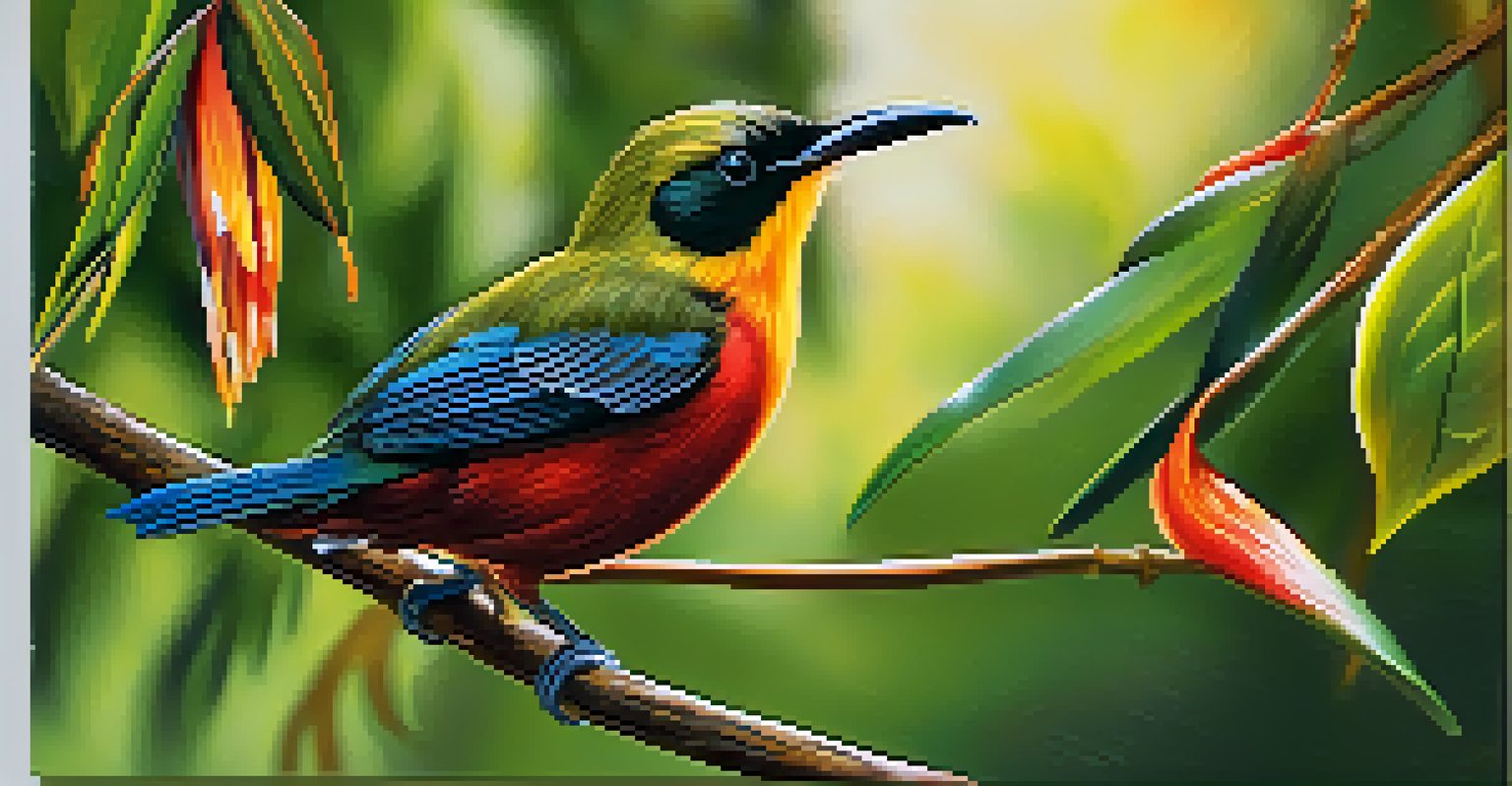Hawaii's Forests: Biodiversity Hotspots in the Pacific

An Introduction to Hawaii's Unique Forest Ecosystems
Hawaii's forests are a treasure trove of biodiversity, representing some of the most unique ecosystems in the world. These forests are home to a dazzling array of plants and animals, many of which can't be found anywhere else on the planet. This isolation has led to the evolution of species that are distinctly Hawaiian, showcasing nature's creativity in adapting to different environments.
The greatest threat to our planet is the belief that someone else will save it.
The native Hawaiian forests are primarily composed of a variety of tree species, including the iconic koa and ohia lehua trees. These trees play a crucial role in maintaining the health of the ecosystem, providing habitat, food, and shelter for countless organisms. Understanding these ecosystems is vital for conservation efforts, as they are under significant threat from invasive species and climate change.
As we delve deeper into Hawaii's forests, we will uncover the intricate relationships among the flora and fauna, and how these relationships contribute to the overall health of the environment. It's a reminder of how interconnected all living things are and the importance of preserving these ecosystems for future generations.
The Rich Biodiversity Found in Hawaiian Forests
Hawaii boasts an impressive number of endemic species, meaning they exist nowhere else in the world. For instance, the Hawaiian honeycreepers are a group of birds that have evolved into many different species, each adapted to specific niches in the forest. This diversity is not just fascinating; it’s essential for the ecological balance of the islands.

Each forest type, from the lush rainforests to the dry forests, supports unique plant and animal life. For example, the rainforests are teeming with ferns, orchids, and birds, while the dry forests showcase hardy plants that have adapted to less water. This variety not only contributes to the beauty of Hawaii's landscapes but also plays a crucial role in carbon storage and soil stabilization.
Hawaii's Unique Biodiversity
Hawaii's forests are home to countless endemic species, highlighting the importance of conserving these unique ecosystems.
Unfortunately, this rich biodiversity is threatened by factors such as habitat destruction, invasive species, and climate change. Protecting these forests is critical, not just for the unique species that inhabit them but also for the overall health of our planet.
Threats to Hawaii's Forest Ecosystems
Despite their beauty and importance, Hawaii's forests face numerous threats that jeopardize their existence. Invasive species, such as rats, feral pigs, and non-native plants, disrupt the delicate balance of these ecosystems. They outcompete native species for resources, leading to a decline in biodiversity and altering the natural landscape.
In every walk with nature one receives far more than he seeks.
Additionally, climate change poses a significant risk, affecting weather patterns, rainfall, and temperatures. These changes can lead to increased vulnerability to pests and diseases, further endangering native species. For instance, the spread of the rapid ohia death disease has decimated vast areas of ohia forests, which are crucial for maintaining the health of the entire ecosystem.
Conservation efforts are underway to address these issues, but they require considerable support and awareness. It is essential for both locals and visitors to understand the importance of protecting these unique environments and to actively participate in conservation initiatives.
Conservation Efforts in Hawaiian Forests
There are numerous organizations and initiatives focused on preserving Hawaii's forests and their biodiversity. Programs like the Hawaii Forest Restoration Initiative work to restore native habitats and combat invasive species through reforestation and community engagement. These efforts often involve local volunteers who help plant native trees and remove harmful invasive species.
Education plays a vital role in conservation. By raising awareness about the significance of Hawaii's unique ecosystems, organizations aim to inspire both residents and tourists to take action. Workshops, guided hikes, and school programs help to instill a sense of stewardship and responsibility towards the environment.
Threats to Forest Ecosystems
Invasive species and climate change pose significant risks to Hawaii's forests, necessitating urgent conservation efforts.
Collaborative efforts between government agencies, non-profits, and local communities are crucial for the success of conservation strategies. By working together, these groups can create comprehensive plans that not only protect the forests but also promote sustainable practices that benefit both people and nature.
The Role of Indigenous Knowledge in Conservation
Indigenous Hawaiian knowledge, or 'kumu ʻike', plays a vital role in the conservation of native forests. This traditional wisdom encompasses an understanding of the land, plants, and animals that have sustained Hawaiian communities for centuries. By integrating this knowledge into modern conservation practices, we can create more effective strategies that respect both the environment and cultural heritage.
Many indigenous practices focus on sustainable resource management, ensuring that the needs of the community are met without compromising the health of the ecosystems. For example, traditional farming methods often include the cultivation of native plants that are better adapted to the local environment and require fewer resources.
By honoring and incorporating indigenous perspectives, conservation efforts can become more holistic and culturally relevant. This approach not only helps to preserve biodiversity but also strengthens community ties and fosters a sense of identity and pride in the natural world.
The Importance of Ecotourism in Hawaii
Ecotourism is an increasingly popular way to explore Hawaii's stunning forests while supporting conservation efforts. This form of tourism emphasizes responsible travel to natural areas, promoting environmental sustainability and benefiting local communities. By participating in ecotourism, visitors can enjoy the beauty of Hawaii's landscapes while contributing to the preservation of these unique ecosystems.
Many ecotourism ventures offer guided tours that educate travelers about the native flora and fauna and the importance of conservation. For instance, hiking tours often include discussions about the threats facing these ecosystems and the ongoing efforts to protect them. This not only enriches the visitor's experience but also raises awareness about the challenges Hawaii's forests face.
Role of Ecotourism in Conservation
Ecotourism promotes responsible travel while financially supporting the preservation of Hawaii's natural resources.
Ultimately, ecotourism creates a financial incentive for communities to preserve their natural resources. When visitors prioritize sustainable practices, they help ensure that these forests remain pristine for future generations to enjoy.
Future Prospects for Hawaii's Forests
The future of Hawaii's forests depends on our collective commitment to conservation and sustainable practices. While the challenges are significant, there is hope in the form of dedicated individuals and organizations working tirelessly to protect these ecosystems. Through education, community engagement, and innovative solutions, we can create a brighter future for Hawaii's unique biodiversity.
Investing in research and monitoring is essential to understanding and mitigating the impacts of climate change and invasive species. By continually assessing the health of these forests, we can adapt our strategies and make informed decisions that prioritize conservation.

As awareness grows and more people become involved in the stewardship of Hawaii's forests, we can foster a culture of respect and care for the environment. A united front will not only help protect these biodiversity hotspots but also ensure that future generations can enjoy the beauty and wonder of Hawaii's forests.